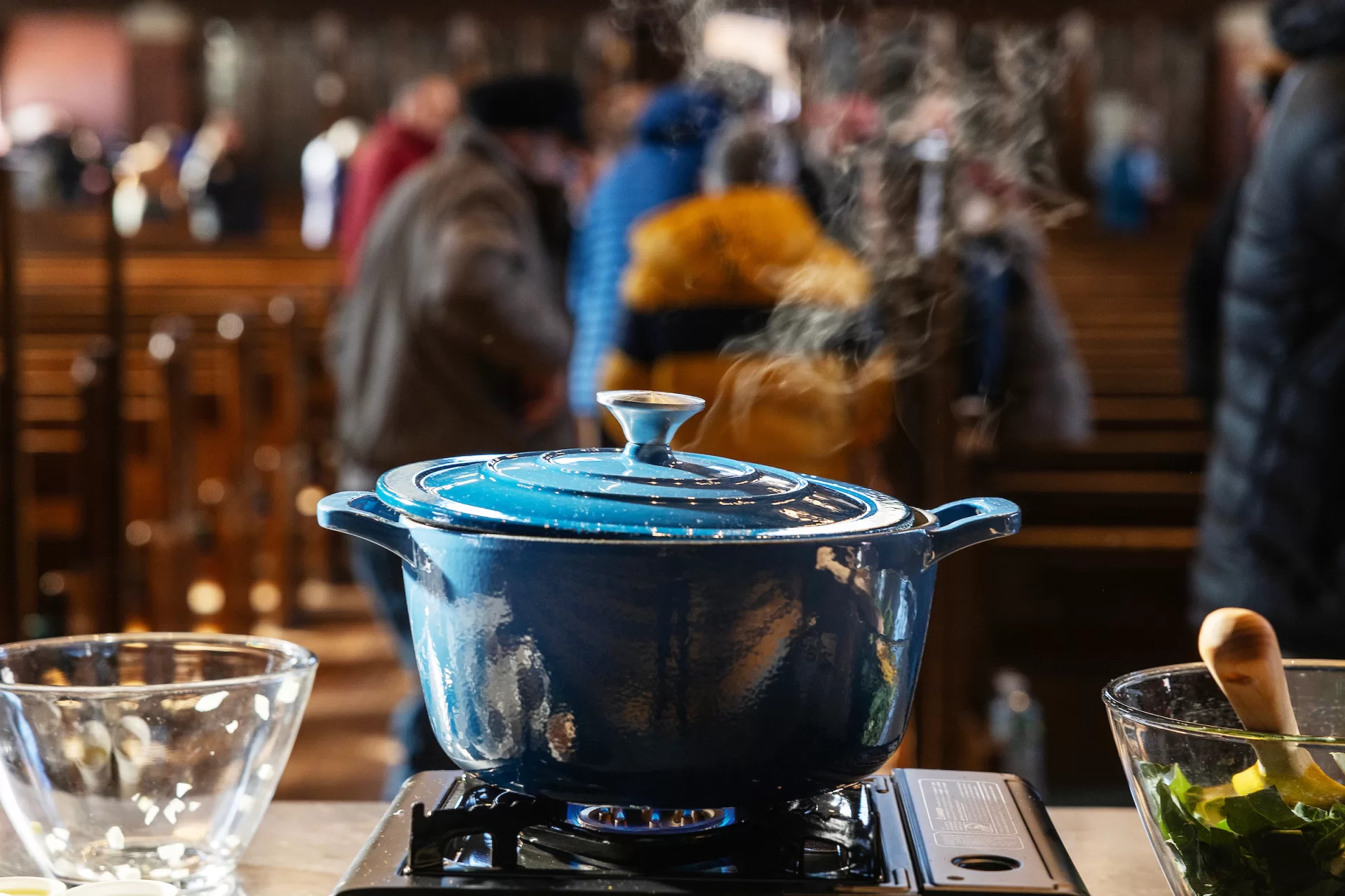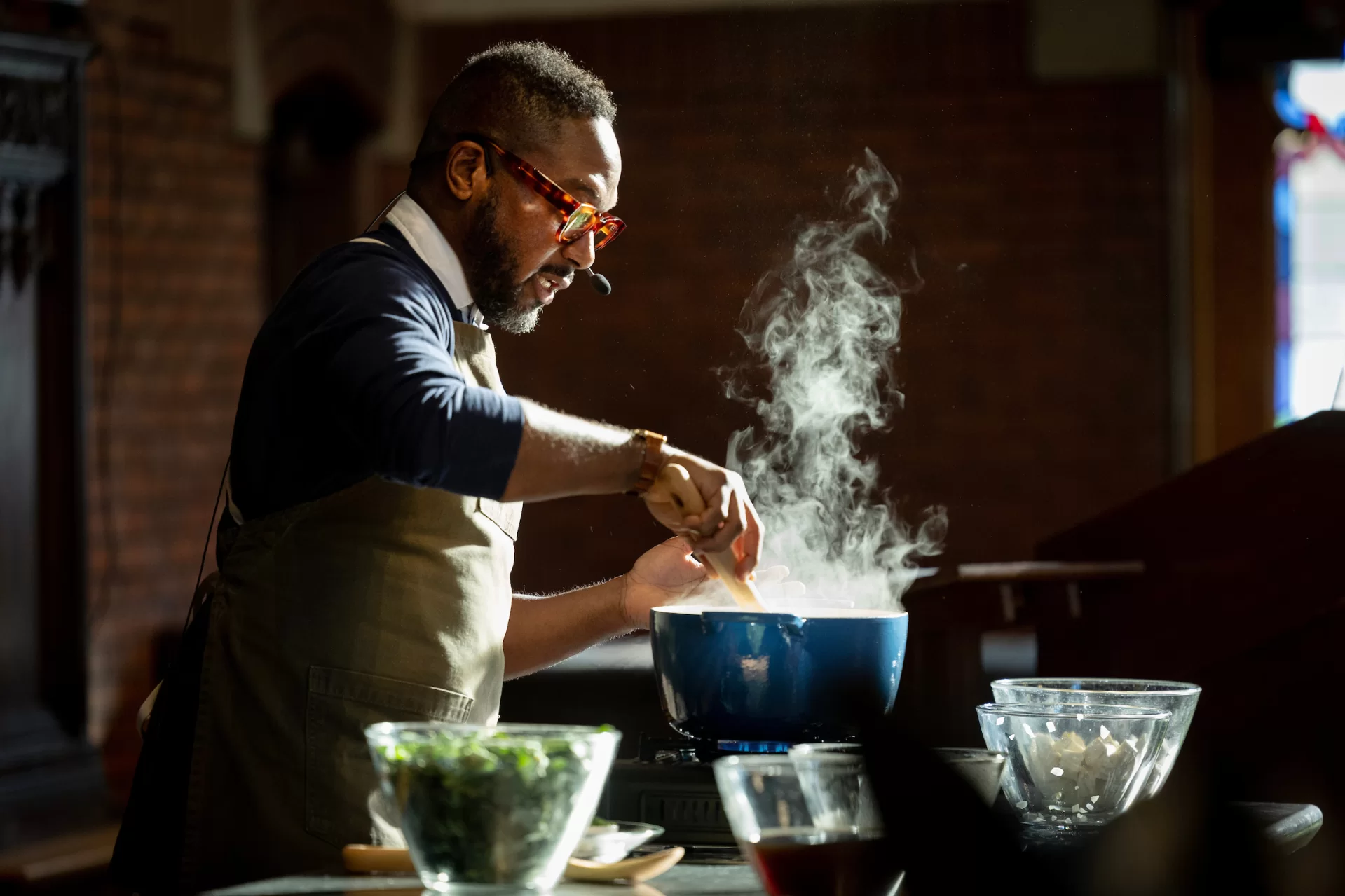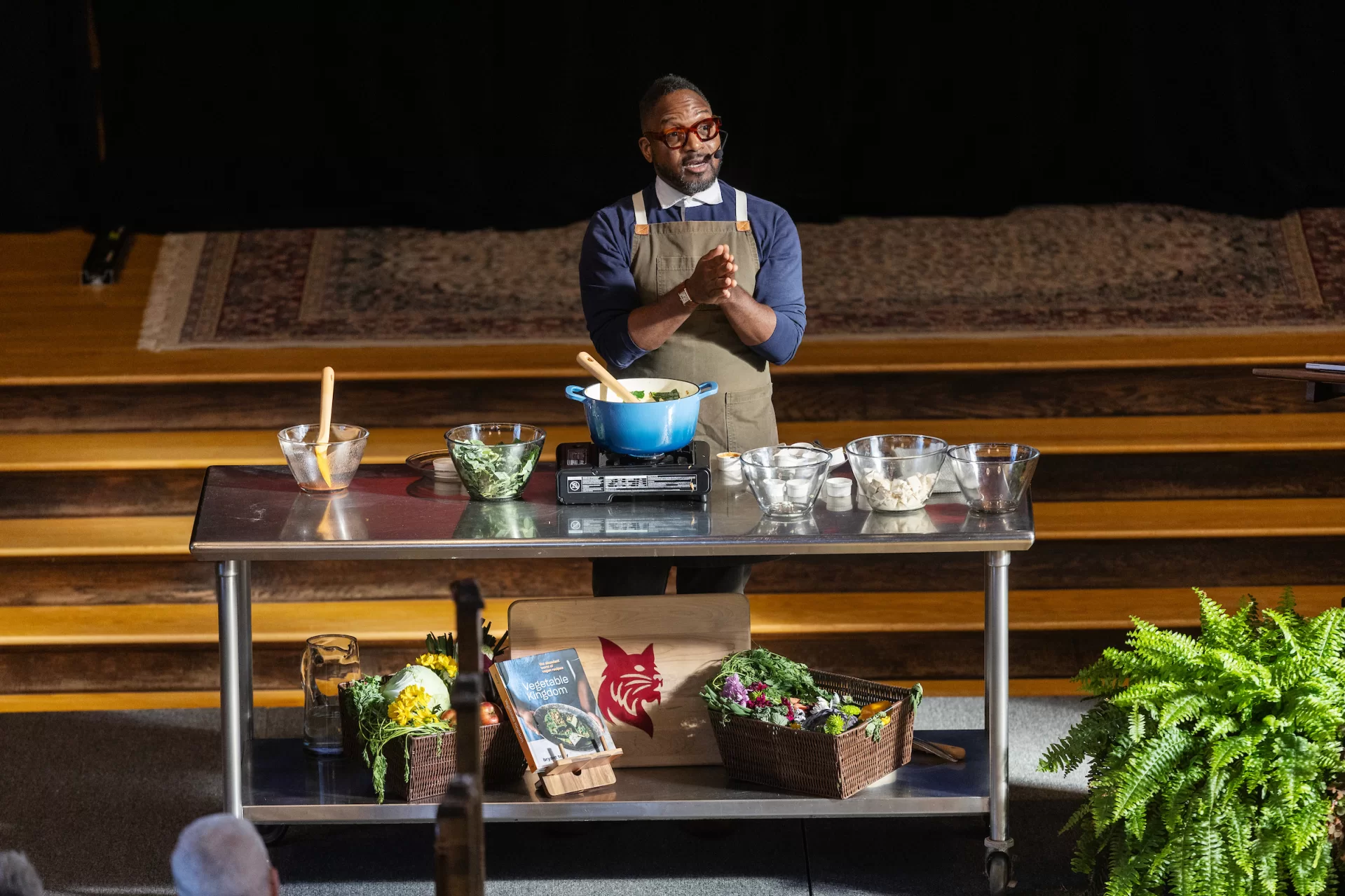
Bryant Terry is a James Beard Award-winning chef, but as he prepared a recipe from one of his cookbooks on Martin Luther King Jr. Day at Bates, he promised his audience that it would be a piece of cake, figuratively speaking.
“If you can boil a pot of water, you can make this dish,” he told the Gomes Chapel audience on Monday during his keynote.
The recipe, for tofu curry with mustard greens, came from his book Afro Vegan and was inspired by a friend’s Tanzanian dish.
As he prepared the dish, he offered his audience cooking tips and insights, while explaining that while the tofu dish is easy, it’s not intended to be quick. Here’s that wisdom, plus 13 other takeaways from the first-ever MLK keynote cooking demonstration.
1. Take it slow, if you can
A proponent of the Slow Food community, like one of the chefs who inspire him, Chez Panisse owner Alice Waters, Terry noted that his recipes are criticized for being time- and labor-intensive. “Yes and yes,” he said, drawing laughter from the crowd in the chapel.

“Our fast culture always has us on the go, always has us thinking about how quickly we can do things. And I encourage us to slow down. This type of cooking practice may not be convenient during the week, but the type of things that you want to make on the weekend.”
2. Cooking is community
American society convinces us to solve problems individually. Instead, Terry said, we should see a more communal way of understanding how we address larger systemic problems.
“I encourage you to think about how you can connect with friends, family, and community to make food,” he said.
3. Tofu isn’t always the answer
Terry agreed that sometimes “tofu is overused,” in vegan or vegetarian dishes. “I reject and rebuke the boring and stereotypical way in which people just delete meat and add tofu: ‘Where there once was a steak, now I’m going to have a big block of tofu and brown sauce.’ We’re not doing that here.”
He did tell his audience to feel free to sub in another protein source. “That’s what I like about this recipe: You can easily substitute chicken or lamb.”
4. Roasting tofu gives it meatiness and bite
The dish Terry prepared calls for roasted tofu, “which gives it a lot of meatiness and bite. Cooked in the right way It actually can be very tasty and filling.”
“Roasting involves preheating an oven to 350 degrees, lining a baking sheet with parchment paper, taking the tofu, tossing in a little olive oil, salting it, and then placing it on the baking sheet and roasting it for about 30 minutes.

“I probably check on it every 10 minutes or so just to turn it to ensure even cooking. That yields a very crispy kind of golden exterior and this creamy interior. So really delicious.”
5. Listen to your body
“We all need to think about our own bodily constitution, our health status, our age. It may be perfect for you to have one specific diet at a moment in your life, but we need to listen to our body and think about the way in which it’s constantly changing and shifting, and really check in with our health team about how we might want to shift our diet to meet its needs accordingly.”
6. Take stock by using stock
When a recipe calls for water, think about using stock. It’s simple, versatile, and adds depth to various dishes. “Anything that requires water, if you’re making rice or quinoa or some type of grain, you can substitute the water with stock to give it more flavor and a little more depth.”
Today, he said, “good-quality and tasty vegetarian and vegan box and bottled stocks are available, even in bouillon cubes. I’m not as self-righteous about using those things as I was a decade ago.”
7. Homemade stock is better
“Making stock at home is super easy to do and it’s pretty incomparable in terms of freshness of flavor,” he said “My wife and I make a big vat of vegetable stock every weekend. And what we do is we make the stock, we cool it down, we transfer it to ice cube trays, freeze those, and then we’ll transfer the trays to Ziploc bags” which makes them easier to use the stock in small batches.
A quick recipe:
- A vegetable stock can be made with a couple of carrots, a head of garlic, and a few onions.
- You don’t even need to peel the onions, he said. “You can simply quarter them. Open the garlic up with the butt of your hand or butt of a knife, just to smash the different garlic cloves. Add some mushrooms, if you want the stock to have a little bit more umami and depth, and maybe some bay leaves.”
- Add two quarters of water to the vegetables, bring to a boil, then lower to a simmer.
- Partially cover, cooking for between 30 to 90 minutes, more “if you really want to extract all the nutrients.”
- “Transfer to a colander, press the solids, and you have this rich, flavorful, delicious stock.”
8. Lose that old spice
Toss out your old spices. Terry noted that his mother loves to cook, but like so many of us, has a drawer of spices dating back to the Clinton administration. “I’m like, ‘Mom, just clean this drawer out!’ Spices lose a lot of their punch as time goes by.”
9. Coax flavor from your spices with heat — but gently
Every dried spice benefits from a little warmth before going into the pot, in a pan over low heat, but do so with caution. “Don’t let your garlic or spices burn,” he said. “Just cook them just until they start to smell fragrant. You want to avoid, when making a soup or stew, dumping in spices into this big vat of liquid. That’s going to prevent the spices from fully incorporating.
When you cook spices with your alliums, it coats them and then it ensures that they’re evenly distributed throughout the dish.”
10. Canned is OK (sometimes)
Terry used canned tomatoes during his demonstration. “I am typically pretty adamant about using fresh ingredients, and you might be saying, ‘Bryant, I wouldn’t expect you to use canned tomatoes. You want to go to the farmer’s market, go to the supermarket and get fresh tomatoes.’”

He makes an exception for tomatoes. “I am totally fine with using canned tomatoes. I don’t like promoting brands, but I will say that Muir Glen is a really good organic tomato brand.”
With good-quality tomato brands that are organic, “they harvest the tomatoes at their ripe of peakedness, and then they immediately process them so that they’re really flavorful and have a lot of nutrient density.”
11. Pursue vibrational cooking
Allow your intuition and creativity to guide your culinary journey.
“The goal is that you should be so adept at cooking and have the fundamental skills that you are using what Vertamae Smart-Grosvenor, the anthropologist and author and actress, calls vibrational cooking, where you’re using your intuition in the spirit of jazz improvisation, you’re using what’s on hand, you’re just kind of flowing.”
12. Adapt recipes to what’s available
Terry’s recipe calls for mustard greens, a staple in American Southern cooking. But mustard greens weren’t available for the demonstration, so Dining Services provided collard greens.
“Recipes should be used as a guide. If you’re growing collards or Swiss chard at home, and the recipe calls for mustard greens, please don’t go out and buy this leafy green. Use what’s on hand. It’s really about making these recipes work for each individual and their family and making things as easy as possible.”
13. Food justice needs all hands on deck
“I don’t expect for you all to abandon your majors and then be committed to food justice activism,” Terry said. “But I do think that we all eat, right. We all eat, right?”

“So we all should be concerned with creating a more healthful, just, and sustainable food system. Whatever talents and skills we could bring to help bring us to a tipping point. You need chefs, you need designers, you need scholars, you need journalists.
“We need all hands on deck to really work towards what I would argue is one of the most important movements of the 21st century.”
TOFU CURRY WITH MUSTARD GREENS — Bryant Terry
Serving Size: 4-6
Ingredients
14 to 16 ounces extra-firm tofu, cut into ½-inch cubes
3 tablespoons plus 2 teaspoons extra-virgin olive oil
¾ teaspoon fine sea salt
¼ teaspoon mustard seeds
1 cup finely diced white onion
2 cloves garlic, minced
1 tablespoon minced fresh ginger
1 ½ teaspoons ground turmeric
½ teaspoon cumin seeds, toasted
6 cardamom pods, seeds removed, toasted and ground
½ teaspoon chili powder
¼ teaspoon freshly ground black pepper
1/4 teaspoon ground ginger
One 14- ounce can of chopped tomatoes with juices
1 jalapeño chile, seeded and minced
1 heaping tablespoon chunky peanut butter
3 cups vegetable stock, homemade or store-bought
12 ounces mustard greens, stemmed and cut into bite-sized pieces
2 bay leaves
2 tablespoons chopped cilantro
Directions:
- Preheat the oven to 450 F. Line a rimmed baking sheet with parchment paper.
- Put the tofu in a bowl, drizzle with 2 teaspoons of the oil, and sprinkle with ¼ teaspoon of the salt. Gently toss the tofu with clean hands until evenly coated.
- Transfer to the lined baking sheet, spreading the tofu in a single layer. Bake, turning once after 15 minutes, for 30 minutes, until firm.
- Warm the remaining 3 tablespoons of oil in a large sauté pan over medium heat. Add the mustard seeds and cook, shaking the pan occasionally, until they pop, 2 to three minutes. Add the onion and the remaining ¾ teaspoon salt and sauté until soft, 5 to 7 minutes. Add the garlic, fresh ginger, turmeric, cumin, cardamom, chili powder, black pepper, garlic powder, and ground ginger and sauté until fragrant, about 2 minutes.
- Add the tomatoes, peanut butter, and jalapeño and stir until well combined.
- Stir in the stock, mustard greens, and bay leaves and bring to a simmer. Decrease the heat to medium low, partially cover, and simmer, stirring occasionally for 20 minutes.
- Gently stir in the tofu and cook for 10 minutes. Remove the bay leaves.
- Taste and season with more salt and black pepper if desired. Serve garnished with the cilantro.
- Enjoy!




